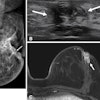When it comes to the hamstrings, strain is the most common type of injury among professional athletes as well as weekend warriors. More precisely, these acute injuries involve the hamstring muscle complex (HMC). For the sports medicine imaging specialist, distinguishing tendon avulsion from HMC strain can determine whether the patient will wind up in the surgical suite. Australian researchers relied on MR and sonography to make that distinction, reporting their results in the online issue of Skeletal Radiology.
Dr. George Koulouris and Dr. David Connell from the St. Francis Xavier Cabrini hospital in Malvern conducted a retrospective review of 170 patients who were referred to their institution for possible HMC injury. In addition to investigating whether imaging could separate tendon avulsion from muscle injury, the group sought to "identify the frequency of muscle involvement, the location of injury within the muscle-tendon-bone unit, and the extent of injury" (Skeletal Radiology, August 27, 2003).
Koulouris is scheduled to present this research next week in Athens, Greece, at the IOC Olympic World Congress on Sport Sciences, sponsored by the International Olympic Committee (IOC).
In total, the duo looked at 179 injuries with a mean duration of symptoms of 4.7 days. The majority of these injuries were sustained while playing Australian Rules football (120). Patients were commonly referred by sports medicine physicians or orthopedic surgeons.
MRI was performed in 97 cases on a 1.5-tesla Signa scanner (GE Medical Systems, Waukesha, WI). A shoulder-array surface coil by Medrad of Indianola, PA, was strapped over the thigh and centered over the maximal region of tenderness. A coronal localizing image was obtained. No contrast was administered, and T1-weighted sequences were not performed because of poor sensitivity to soft-tissue abnormalities, the authors explained.
In 102 cases, sonography was done on an HDI 5000 (ATL, Philips Medical Systems, Bothell, WA), along the longitudinal and transverse planes. Twenty patients underwent both types of imaging.
According to the results, the breakdown of the 179 injuries included 154 patients with muscle belly injuries and 21 cases of proximal tendon-bone injuries. Of the latter, there were 16 instances of avulsion from ischial tuberosity and five cases of partial tears. Based on the MR exam, avulsion was correctly identified in all 16 cases and subsequently confirmed during surgical reattachment.
Ultrasound was less reliable for revealing conjoint tendon avulsion, often confusing a torn hamstring with hemorrhage. Also, the mixed echogenic pattern on ultrasound associated with large hematomas, which are present with avulsion, made it difficult to detect the retracted tendon, the authors stated.
On the other hand, "coronal oblique (MR) imaging is useful for assessing the degree of retraction...the amount of tendon retraction and the tendon edge morphology are important features for preoperative assessment," they concluded.
Five of the 21 patients with avulsion had partial tears of the hamstring origin, which were "characterized by fluid-filled cleavage plans disrupting the normal uniform signal on MR imaging...."
On MR, hamstring muscle injury was manifest by a high signal on T2-weighted imaging secondary to edema. The high signal of edema contrasted well against the isointense gray signal of normal muscle. The researchers found sonography to be the most helpful for imaging superficial tendons around the knee.
The most common hamstring muscle injuries were of the biceps femoris (80.5% of the cases), followed by injuries of the musculotendinous junction of the biceps (61.3%). The longitudinal extent of the tear ranged from 30-152 mm.
"Discriminating the type of muscle injury may be important for prognosis, as patients with deep muscle tears remained out of competition longer than those with superficial tears," the authors stated.
By Shalmali PalAuntMinnie.com staff writer
September 29, 2003
Related Reading
Boning up on musculoskeletal MR basics at ISS, September 18, 2003
X-rays and the boys of summer: Imaging goes to bat for baseball injuries, April 15, 2003
Musculoskeletal ultrasound on the rise, may yield cost savings, January 1, 2003
The role of MRI and US in acute hamstring injuries: A preliminary report, July 22, 2002
MRI spots hamstring injuries, keeps skaters flying high, February 25, 2002
Copyright © 2003 AuntMinnie.com


.fFmgij6Hin.png?auto=compress%2Cformat&fit=crop&h=100&q=70&w=100)





.fFmgij6Hin.png?auto=compress%2Cformat&fit=crop&h=167&q=70&w=250)











